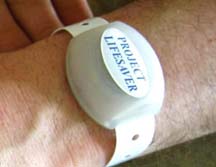Project Lifesaver
Project Lifesaver Protects Wandering Patients and Gives Peace of Mind to Caregivers, Families and Communities.
Project Lifesaver is an innovative and rapidly growing program aiding the victims and families suffering Alzheimer's Disease and related disorders such as Down's Syndrome and Autism. Project Lifesaver uses state-of-the-art technology employing wristband transmitters to locate wandering and lost adults and children.
Over 5,000,000 people in the USA have Alzheimer's. That number will triple by 2050. Well over 50% of these people wander and become lost. A lost person with Alzheimer's or other dementia represents a critical emergency as nearly half of them will die and many can become injured or fall victim to predators if they are not located within 24 hours. The number of people, families and communities experiencing this risk will grow dramatically in this decade.
If you are not yet touched in some way by Alzheimer's or related disease, chances are you will be within the next several years. You will find it among neighbors, your friends, co-workers and their families, and perhaps within your own family.
The name Project Lifesaver has become internationally recognized as an active and proven program that saves lives.
How Project Lifesaver Works
Project Lifesaver is much more than a passive ID bracelet. It is an active system that relies on state-of-the-art technology and a specially trained search and rescue team. People who are part of the Project Lifesaver program wear a personalized bracelet that emits a tracking signal. When caregivers notify the local Project Lifesaver agency that the person is missing, a search and rescue team responds to the wanderer's area and starts searching with the mobile locater tracking system. Search times have been reduced from hours and days to minutes. In hundreds of searches, there have been no reported serious injuries or deaths. Recovery times average less than 30 minutes.
 The Project Lifesaver CARE TRAK bracelet is much more than a passive ID bracelet. It is a one-ounce battery-operated radio wrist transmitter emitting an automatic tracking signal every second, 24 hours a day. The signal is tracked on the ground or in the air over several miles. As each bracelet has a unique radio frequency, the Project Lifesaver search team positively locates and identifies the person who has wandered away from home or a care facility.
The Project Lifesaver CARE TRAK bracelet is much more than a passive ID bracelet. It is a one-ounce battery-operated radio wrist transmitter emitting an automatic tracking signal every second, 24 hours a day. The signal is tracked on the ground or in the air over several miles. As each bracelet has a unique radio frequency, the Project Lifesaver search team positively locates and identifies the person who has wandered away from home or a care facility.
Technology is Only Half the Story
Members of the Project Lifesaver team are specially trained, not only in use of the electronic tracking equipment, but especially in the methods to communicate with a person who has Alzheimer's disease or related disorder. Locating the individual is only part of the mission. The person who is located will be disoriented, anxious, and untrusting. The Project Lifesaver teams know how to approach the person, gain their trust and put them at ease for the trip back home.
Educational and community awareness programs have been a cornerstone to Project Lifesaver's success. Project Lifesaver team members are also active in presenting information to civic groups, law enforcement agencies and various healthcare providers throughout their communities.

 The Project Lifesaver CARE TRAK bracelet is much more than a passive ID bracelet. It is a one-ounce battery-operated radio wrist transmitter emitting an automatic tracking signal every second, 24 hours a day. The signal is tracked on the ground or in the air over several miles. As each bracelet has a unique radio frequency, the Project Lifesaver search team positively locates and identifies the person who has wandered away from home or a care facility.
The Project Lifesaver CARE TRAK bracelet is much more than a passive ID bracelet. It is a one-ounce battery-operated radio wrist transmitter emitting an automatic tracking signal every second, 24 hours a day. The signal is tracked on the ground or in the air over several miles. As each bracelet has a unique radio frequency, the Project Lifesaver search team positively locates and identifies the person who has wandered away from home or a care facility. 
